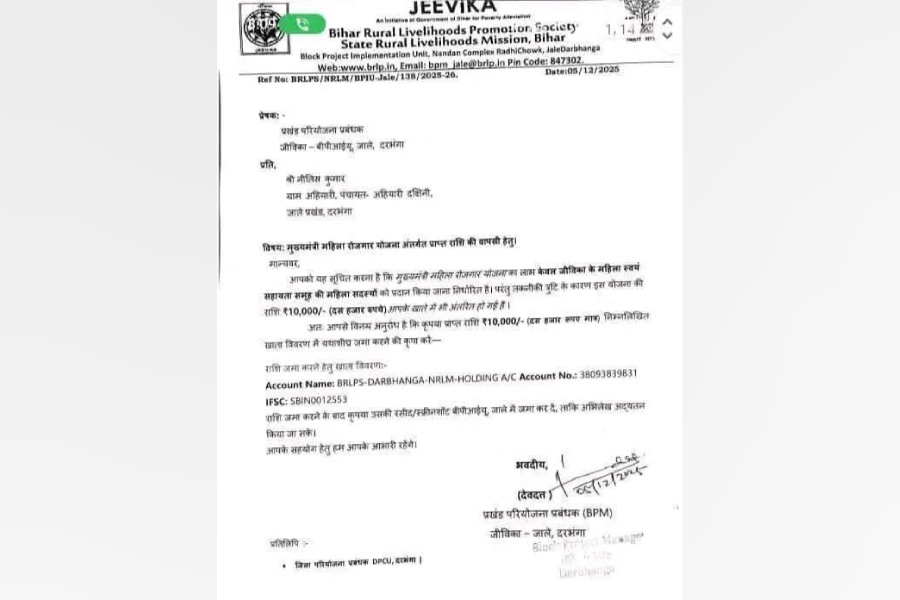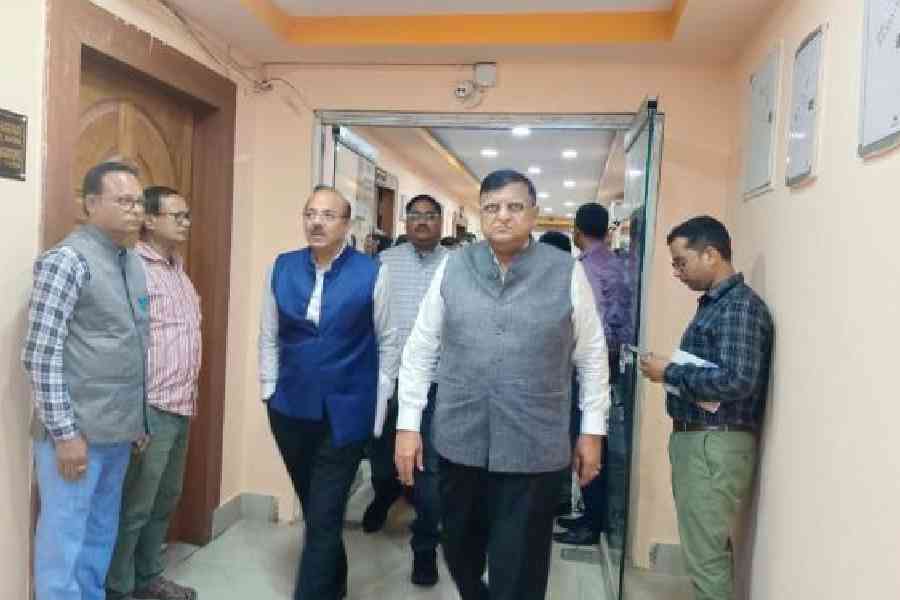 |
| Dia and Priyanshu in Paanch Adhyay |
Vicky Donor maker Shoojit Sircar watched Paanch Adhyay and turned the tables on Pratim D. Gupta over a cuppa at Flurys.
Shoojit: This is not a review or a criticism interview. Today we are on the sixth day of Paanch Adhyay. How are you feeling?
Pratim: Very good. Very happy. The film’s being liked. There are many who are watching it more than once. So many filmmakers and actors in Calcutta and Mumbai have called to say how much they loved the movie. It’s a great feeling. Also, the film has made it to two important festivals (Mumbai Film Festival and South Asian International Film Festival in New York), thus getting a national premiere and an international premiere. What more can a first-time filmmaker ask for?
S: Was the transition from a film critic to a film director smooth?
P: The writing bit, there is definitely a connection. Writing interviews, features and reviews and even news stories for The Telegraph for almost a decade now has really helped me develop my own style. And I would like to believe that the style has crept into the writing of my screenplays. Whether it’s wordplay or humour… constant writing for the newspaper has loosened me up considerably. But direction was a different animal. Nothing that you write about films can ever prepare you to fight the war that is filmmaking. I always had a feeling that it would be like this. And that is why I chose a story which is very simple. I wanted to get the basics right. Of course, I went more and more wild with the form with every passing day.
S: I was trying to find moments where you get conscious of who you are. As a critic you have lauded so many films and you have trashed so many films; so I wanted to see whether that aspect came out anywhere. But it never did. Every time it was almost there, you somehow brushed past. Were you ever worried that now your film will be reviewed?
P: No, I was way too happy to make the film. It’s been a dream for so long. I wanted to enjoy every moment of the process and I have. It’s been the best year of my life and the happiness continues as I go to theatres to watch the film with the audience and take it to festivals. Also, my main cast and crew are extremely proud of Paanch Adhyay. Dee (Dia Mirza) and PC (Priyanshu Chatterjee) are ecstatic! Everyone’s calling them up to say it’s their best work. Shantanu-da (Moitra) and Arghya-da (Arghyakamal Mitra) are so happy. They never allowed me to worry about anything.
S: Let’s go into the film now. Soumitra-da’s (Chatterjee) character has very strong words to say about the Bengali film industry. ‘How long will Bengalis milk Rabindranath Tagore and Satyajit Ray?’ Is that what you want to say?
P: I am certainly disturbed about it. There have been many Bengali films which believe that adding one Rabindrasangeet will give them a certain respectability. That’s so sad. Also, the way Ray has been used, misused and abused on screen and off screen is not fair to such a great filmmaker. Plus self-criticism is a recurring motif in the film. The characters do things in the movie that other characters criticise them for. Arindam is doing a new adaptation of Charulata and he is admonished for that. He copies Black Swan and is taken apart by his own actor. Ranja (Sampurna) plays tricks with Arindam and he lashes out at her. I wanted the characters to voice what the audiences feel. I wanted someone on screen to ask the girl to “shut up” before someone in the audience wants her to “shut up”.
S: You have these two characters trying to pull off this whole film of two hours. It’s a very tough job. Like Clint Eastwood and Meryl Streep in Bridges of Madison County or Leonardo DiCaprio and Kate Winslet in Revolutionary Road. Were you not scared of doing an entire film with Dia and Priyanshu?
P: I am a huge believer in the theory that secondary and tertiary characters and secondary and tertiary plots dilute the main essence of the film. Mr Tarantino is my guru here. He made a five-hour film about one woman trying to kill five people. No parents, no friends…. The kind of lives we lead today, we are all on our own. We may share time and spaces with people but we are all fighting our own individual battles. I really believe it’s a reflection of our times. Also, cinematically, the plot remains tight and moves from action to action. Both my leads were so much into the script, I was very confident they would deliver.
S: They certainly delivered. And I must congratulate you that handing such a mature subject with just two people is not an easy job. In regular day-to-day life are you an optimistic person or a pessimistic person?
P: What does the film tell you?
S: The film tells me that you are very optimistic. What you have shown so beautifully is that there will be incidents that will completely disintegrate you but that is not the end of the world. The love story stays etched forever whether the people are around or not. That’s a great message. Now, coming to my favourite scene — when Priyanshu comes home after that torrid rainy night and Dia is waiting for him. I have seen Dia in so many scenes in so many films. She also has a role in my unreleased Shoebite. But here she is at her best. How did you direct your two actors in that scene?
P: Oh, we three love that scene too. For me it was about her keenness to hug him and his desperation to stay away from her. Also, the point at which that scene came, there was an inherent tension anyway. And yes, the two are so good in that scene. It seems almost like she is trying to clasp the relationship and he is trying to fend it off. There I am talking like a critic again!
S: One thing that bothered me is that there is very little physical change in the character going through a difficult disease…
P: I didn’t want to take that clichéd route of adding dark circles and making someone look terrible just because she has a disease. So after much consultation with a doctor friend, we decided on this particular disease which doesn’t affect you physically until you go for radiation or chemotherapy. Plus I wanted to avoid manipulating the audiences and squeezing out the tears. That positive message you mentioned would have got smudged with the tears then.
S: I found the three characters extremely well cast. Not just Dia and Priyanshu but the other girl (Sampurna). Was casting her difficult?
P: I had auditions and from the girls we auditioned, Sampurna’s real-life persona came closest to the character of Ranja. I did rewrite it a bit making her a small-town girl who reacts to situations as if she is inside a TV soap, the kind of soaps and serials she must have been watching all day back home. I wanted her to be in complete contrast to the dignified and classy Ishita.
S: Coming to the music, was it difficult to handle Shantanu Moitra?
P: It wasn’t easy initially because we were both trying to understand each other’s way of working. And we are such different people. I try to plan things in advance and he doesn’t know what he is doing two hours later. But once he saw the rough cut of the film, everything changed. The film inspired Shantanu-da so much, he ended up making seven songs. Now, I can’t imagine working with someone else.... Do you think we overdid the background score?
S: No, I thought it was fine. The film is also about silence and one of the toughest things in cinema is to handle silence and you do that remarkably in your first film. Is there anything you would like to change about the film now? Or is it too early to be objective?
P: The first chapter. I wanted that adhyay to be fun and wacky and in hindsight the flavour of the rest of the film is so different that it sticks out like a sore thumb. I should have written and shot the “falling in love” bit differently.
S: Finally, where do you go from here? You have arrived as a filmmaker. Will you write reviews or will you be only a filmmaker?
P: I haven’t planned it. Yes, learning from Shantanu-da! Yes, I have scripts ready and am finishing one now, which I am very, very excited about. Of course, I love writing about films. But if there is ever a clash of interest, I would stop doing one of the two things.
S: Lovely, Pratim! I would like to say that as a first film, you have showed your directorial skills extremely well, experimenting with form and structure and making use of music. Keep it up! And I will be watching out for what you do next!
Imtiaz Ali: Paanch Adhyay
A time-glistened Soumitra Chatterjee radiates screen Zen. “If you do not feel it, do not fake it. If you do feel it, do not f*** it up.”
As the movie began I thought Pratim had f***ed it up. What the hell…, I am thinking early in the first ‘Adhyay’. This looks wannabe Bollywood and amateurish. What is the big fuss about this movie? But as the chapters turn in the film, I realised that this is a huge example of a film that improves itself as it runs. So by the middle of the second chapter, I found myself lost in the carefully selected Calcuttascapes, enchanted by the classic tragic-romantic women in the story and enthralled by Shantanu’s inspiring music.
Before you realise it you are in the lives of a movie director, his wife and his latest ‘find’ and all of what is happening on the screen really matters to you. And you are looking at the screen thinking that things might tilt to a cliche or a convenience but the movie continues to gather more and more vitality and becomes a very well-balanced, well-told tale. And this is the time to welcome a new filmmaker with exciting promise to the Indian film industry. Welcome, Pratim.
Dia was beautifully cast. It also seemed one of those parts in the life of an actor to which you connect in the deepest manner. The combination of these gives Bengali cinema a modern Charulata. Priyanshu’s performance was unbelievably inconsistent. But the bad parts of this inconsistency were very few and mostly towards the beginning. He manages to gain the love of the audience for his character even when it does unacceptable things in the movie.
The second lead girl (Sampurna) turns out to be a surprisingly good actor. Comes in ordinary, but in the culture of the film, suddenly gets into top gear from the scene inside the car at night.
Wonderful lyrics and singing. Music strikes a quirky balance of a modern and traditional. Detailed and effective art work, thoughtful camera compositions and a rapid pace make the movie an emotional experience. And at the end of it, you realise that the filmmaker did ‘feel it’ and did not ‘f*** it up’.










